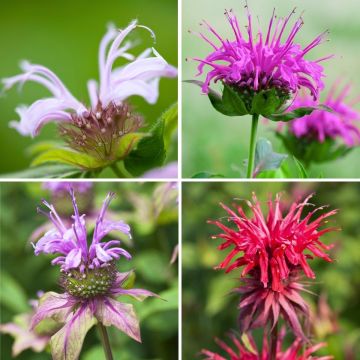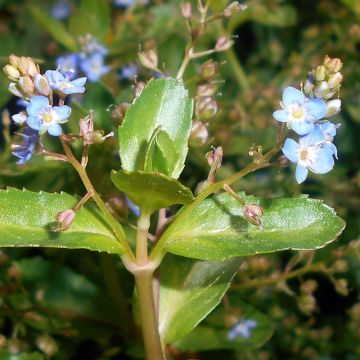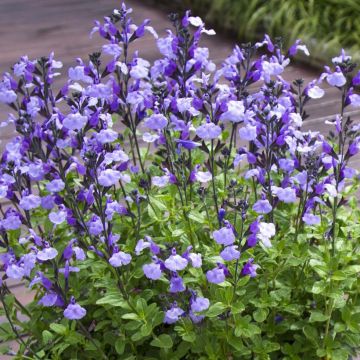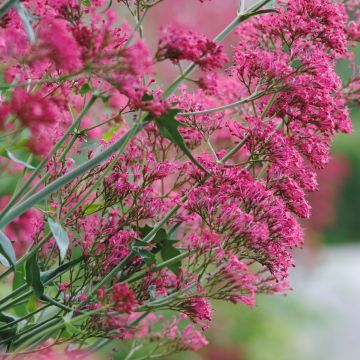

Monarda Bee-True - Beebalm


Monarda Bee-True - Beebalm


Monarda Bee-True - Beebalm


Monarda Bee-True - Beebalm
Monarda Bee-True - Beebalm
Monarda x Bee-True
Bergamot, Bee Balm, Oswego Tea, Horsemint
Special offer!
Receive a €20 voucher for any order over €90 (excluding delivery costs, credit notes, and plastic-free options)!
1- Add your favorite plants to your cart.
2- Once you have reached €90, confirm your order (you can even choose the delivery date!).
3- As soon as your order is shipped, you will receive an email containing your voucher code, valid for 3 months (90 days).
Your voucher is unique and can only be used once, for any order with a minimum value of €20, excluding delivery costs.
Can be combined with other current offers, non-divisible and non-refundable.
Why not try an alternative variety in stock?
View all →This plant carries a 12 months recovery warranty
More information
We guarantee the quality of our plants for a full growing cycle, and will replace at our expense any plant that fails to recover under normal climatic and planting conditions.
Would this plant suit my garden?
Set up your Plantfit profile →
Description
Monarda 'Bee-True' is part of the Bee-You series, whose floriferous and compact cultivars, are known for their resistance to powdery mildew. 'Bee True' is a nectar-rich variety with raspberry-red flowers with a deep red centre and a velvety appearance. Its rich and vibrant flowers bloom all summer long with shiny, finely-cut petals like ruffled bracts, above small purple-green bracts. This tall perennial, also known as Bergamot, is distinguished by its vigorous growth. It has dark green, aromatic, toothed and veined foliage, further accentuating the flamboyant colour of the flowers. It is an easy plant to grow in moist and fertile soil, in full sun or partial shade. It is also an excellent cut flower.
Monarda 'Bee True' belongs to the Lamiaceae family, which includes many medicinal and aromatic plants. This herbaceous perennial is part of the numerous hybrids obtained through cross-breeding between two wild species, Monarda didyma, the Purple Bergamot, and M. fistulosa, both native to North America. It forms a compact, upright clump 50 cm (20in) in all directions. Flowering occurs for 8 weeks in the middle of summer from July to September with unique, tousled flowers. They are composed of small flowers 4 to 5 cm (2in) long, surrounded by bracts resembling small leaves, and have an upright upper lip and a more spread-out lower lip divided into three lobes, perched on upright stems. Bees and pollinators love the flowers. The dark green, aromatic and healthy foliage emits a characteristic citrus scent when crushed. The opposite, veined, and toothed leaves measure 10 to 15 cm (4 to 6in) long and often attract insects. This plant covers the ground in two or three years without becoming invasive. It is very hardy and long-lived if the growing conditions are good.
Monarda Bee True goes well with summer-flowering perennials in vibrant colours like Helianthus or pastel colours like Phlox. Plant it in groups of six to create a beautiful mass of flowers, and associate it with Daylilies. In late summer, it pairs well with Asters, Bellflowers, Echinaceas, and other perennial plants. This compact variety also thrives in pots. Its flowers are delightful and long-lasting as cut flowers.
It is worth noting that Monarda contains essential oils similar to those of thyme and its fresh or dried leaves or flowers can be used to make herbal tea. The young shoots can be used in salads or stuffing.
Flowering
Foliage
Plant habit
Botanical data
Monarda
x
Bee-True
Lamiaceae
Bergamot, Bee Balm, Oswego Tea, Horsemint
Cultivar or hybrid
Other Monarda - Bee Balm
View all →Planting and care
Monardas are perennial plants that don't like dry soil and exposures that are too hot, which promote powdery mildew attacks, this can still be a problem in moist soil. But not with 'Bee True'. These plants generally need moist, very well-drained, rich, but light and humus-rich soil and they tolerate competition from other roots poorly. After planting, mulch the base with a layer of dead leaves or anything that can maintain moisture in the soil. Winter wet is bad for monardas, so good drainage is very important. Water regularly in summer drought. In autumn, cut back the withered stems to ground level. In poor soils, spread well-rotted compost over the crowns.
Planting period
Intended location
Care
Planting & care advice
This item has not been reviewed yet - be the first to leave a review about it.
Similar products
Haven't found what you were looking for?
Hardiness is the lowest winter temperature a plant can endure without suffering serious damage or even dying. However, hardiness is affected by location (a sheltered area, such as a patio), protection (winter cover) and soil type (hardiness is improved by well-drained soil).

Photo Sharing Terms & Conditions
In order to encourage gardeners to interact and share their experiences, Promesse de fleurs offers various media enabling content to be uploaded onto its Site - in particular via the ‘Photo sharing’ module.
The User agrees to refrain from:
- Posting any content that is illegal, prejudicial, insulting, racist, inciteful to hatred, revisionist, contrary to public decency, that infringes on privacy or on the privacy rights of third parties, in particular the publicity rights of persons and goods, intellectual property rights, or the right to privacy.
- Submitting content on behalf of a third party;
- Impersonate the identity of a third party and/or publish any personal information about a third party;
In general, the User undertakes to refrain from any unethical behaviour.
All Content (in particular text, comments, files, images, photos, videos, creative works, etc.), which may be subject to property or intellectual property rights, image or other private rights, shall remain the property of the User, subject to the limited rights granted by the terms of the licence granted by Promesse de fleurs as stated below. Users are at liberty to publish or not to publish such Content on the Site, notably via the ‘Photo Sharing’ facility, and accept that this Content shall be made public and freely accessible, notably on the Internet.
Users further acknowledge, undertake to have ,and guarantee that they hold all necessary rights and permissions to publish such material on the Site, in particular with regard to the legislation in force pertaining to any privacy, property, intellectual property, image, or contractual rights, or rights of any other nature. By publishing such Content on the Site, Users acknowledge accepting full liability as publishers of the Content within the meaning of the law, and grant Promesse de fleurs, free of charge, an inclusive, worldwide licence for the said Content for the entire duration of its publication, including all reproduction, representation, up/downloading, displaying, performing, transmission, and storage rights.
Users also grant permission for their name to be linked to the Content and accept that this link may not always be made available.
By engaging in posting material, Users consent to their Content becoming automatically accessible on the Internet, in particular on other sites and/or blogs and/or web pages of the Promesse de fleurs site, including in particular social pages and the Promesse de fleurs catalogue.
Users may secure the removal of entrusted content free of charge by issuing a simple request via our contact form.
The flowering period indicated on our website applies to countries and regions located in USDA zone 8 (France, the United Kingdom, Ireland, the Netherlands, etc.)
It will vary according to where you live:
- In zones 9 to 10 (Italy, Spain, Greece, etc.), flowering will occur about 2 to 4 weeks earlier.
- In zones 6 to 7 (Germany, Poland, Slovenia, and lower mountainous regions), flowering will be delayed by 2 to 3 weeks.
- In zone 5 (Central Europe, Scandinavia), blooming will be delayed by 3 to 5 weeks.
In temperate climates, pruning of spring-flowering shrubs (forsythia, spireas, etc.) should be done just after flowering.
Pruning of summer-flowering shrubs (Indian Lilac, Perovskia, etc.) can be done in winter or spring.
In cold regions as well as with frost-sensitive plants, avoid pruning too early when severe frosts may still occur.
The planting period indicated on our website applies to countries and regions located in USDA zone 8 (France, United Kingdom, Ireland, Netherlands).
It will vary according to where you live:
- In Mediterranean zones (Marseille, Madrid, Milan, etc.), autumn and winter are the best planting periods.
- In continental zones (Strasbourg, Munich, Vienna, etc.), delay planting by 2 to 3 weeks in spring and bring it forward by 2 to 4 weeks in autumn.
- In mountainous regions (the Alps, Pyrenees, Carpathians, etc.), it is best to plant in late spring (May-June) or late summer (August-September).
The harvesting period indicated on our website applies to countries and regions in USDA zone 8 (France, England, Ireland, the Netherlands).
In colder areas (Scandinavia, Poland, Austria...) fruit and vegetable harvests are likely to be delayed by 3-4 weeks.
In warmer areas (Italy, Spain, Greece, etc.), harvesting will probably take place earlier, depending on weather conditions.
The sowing periods indicated on our website apply to countries and regions within USDA Zone 8 (France, UK, Ireland, Netherlands).
In colder areas (Scandinavia, Poland, Austria...), delay any outdoor sowing by 3-4 weeks, or sow under glass.
In warmer climes (Italy, Spain, Greece, etc.), bring outdoor sowing forward by a few weeks.






























































